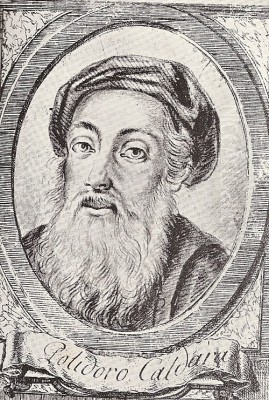
Polidoro Caldara, universally known in art history as Polidoro da Caravaggio, stands as a significant yet often underappreciated figure of the Italian High Renaissance and early Mannerist periods. His name, "da Caravaggio," signifies his origin from the town of Caravaggio in Lombardy, a place later made famous by another artistic titan, Michelangelo Merisi da Caravaggio, though the two were distinct individuals from different eras. Polidoro's life was one of remarkable artistic ascent, marked by innovation in fresco and façade decoration, and tragically cut short. His story, as chronicled by early art historians like Giorgio Vasari, paints a picture of a gifted artist whose work left an indelible mark on the visual landscape of Rome and Southern Italy.
Early Life and Arrival in Rome
The precise birth year of Polidoro Caldara remains a subject of some scholarly debate, with sources suggesting dates around 1492, 1494, or 1495. He was born in the small town of Caravaggio in Lombardy, a region rich in artistic traditions. Little is known about his earliest years or any formal artistic training he might have received in his hometown. Like many aspiring artists and craftsmen of his time, Polidoro was drawn to Rome, the vibrant center of the Renaissance, seeking opportunity and a chance to immerse himself in the classical and contemporary artistic fervor that defined the city.
It is generally believed that Polidoro arrived in Rome around 1514 or shortly thereafter, perhaps as a young man of about eighteen. His beginnings in the Eternal City were humble. According to Vasari, he initially found work as a laborer, specifically carrying mortar and materials for the painters engaged in the decoration of the Vatican Logge under the direction of the great Raphael Sanzio. This menial role, however, placed him at the epicenter of artistic creation, allowing him to observe firsthand the techniques and creative processes of some of the era's leading masters.
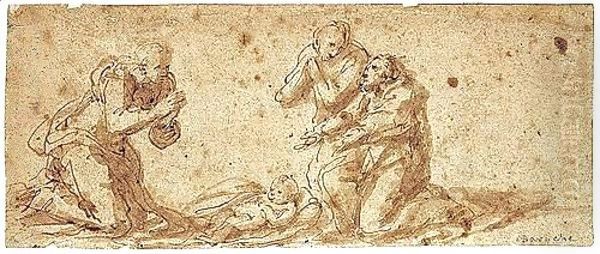
This proximity to artistic genius ignited Polidoro's own latent talents. He began to practice drawing, diligently copying the works he saw around him. His dedication and burgeoning skill did not go unnoticed, particularly by the artists in Raphael's workshop. This informal, self-driven education laid the foundation for his future career, demonstrating a tenacity and passion for art that would characterize his life.
Apprenticeship and the Influence of Raphael
Polidoro's talent for drawing and his quick grasp of artistic principles soon caught the attention of prominent figures within Raphael's extensive workshop. While not a formal apprentice in the traditional sense from the outset, his association with this powerhouse of creativity was transformative. Raphael's workshop was a bustling enterprise, responsible for some of the most ambitious decorative projects of the High Renaissance, including the Vatican Stanze and the aforementioned Logge.
Working in such an environment, Polidoro was exposed to the highest standards of design, composition, and execution. He absorbed Raphael's classicizing style, characterized by harmony, balance, and idealized human forms. He would have collaborated with, or at least worked alongside, other gifted artists in Raphael's circle, such as Giulio Romano, Perino del Vaga, and Giovanni da Udine. Giulio Romano, known for his powerful and dynamic style, and Perino del Vaga, celebrated for his elegant and decorative work, were key figures who continued Raphael's legacy after his untimely death in 1520. Giovanni da Udine was a specialist in stucco work and grotesque decorations, reviving ancient Roman ornamental motifs.
Polidoro's involvement in the Vatican Logge project, even if initially in a minor capacity, provided invaluable experience. He learned the complexities of large-scale fresco painting, the art of adapting designs to architectural spaces, and the importance of collaborative work. The influence of Raphael's classicism is evident in Polidoro's early works, particularly in his figure drawing and his approach to narrative composition. However, Polidoro was not merely an imitator; he began to forge his own distinct artistic identity, increasingly drawn to dramatic expression and innovative techniques.
Collaboration with Maturino da Firenze and the Art of Façade Painting
A pivotal relationship in Polidoro da Caravaggio's career was his close friendship and artistic partnership with Maturino da Firenze (Maturino di Francesco Tofani). Maturino, another painter active in Rome, shared Polidoro's passion for classical antiquity and a similar artistic temperament. Together, they formed a highly successful duo, specializing in the decoration of palace façades with monochrome frescoes, a technique known as grisaille, and sgraffito.
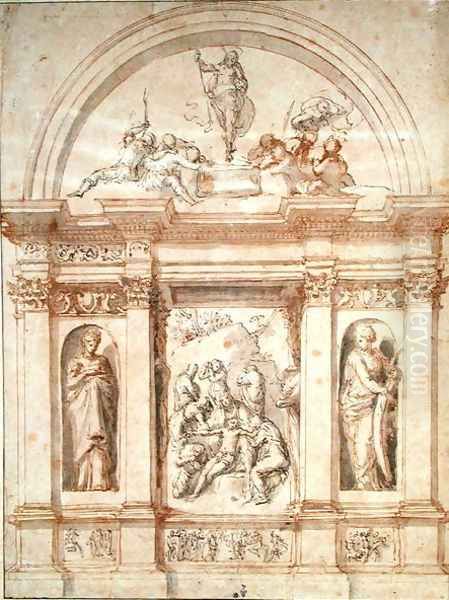
During the early 16th century, it became fashionable in Rome for noble families and wealthy patrons to adorn the exterior walls of their palazzi with elaborate painted narratives. These decorations, often depicting scenes from Roman history, mythology, or allegorical subjects, served as public displays of culture, erudition, and status. Polidoro and Maturino excelled in this genre, transforming the streets of Rome into open-air galleries. Their works were celebrated for their inventive compositions, their skillful emulation of classical reliefs, and their dynamic portrayal of figures.
Their collaborative process was reportedly so seamless that Vasari claimed it was often difficult to distinguish their individual hands. They worked on numerous façades, including those of the Palazzo Ricci and the Palazzo Milesi (though many of these are now lost or severely deteriorated due to exposure to the elements). The technique of sgraffito, which involved scratching a design through a top layer of plaster to reveal a contrasting layer beneath, was particularly suited to creating bold, graphic effects that resembled carved stone. Their grisaille frescoes, executed in shades of grey or other neutral tones, mimicked the appearance of sculpture, lending a sense of classical grandeur to the buildings. This specialization brought them considerable fame and numerous commissions. The architect and painter Baldassare Peruzzi was another contemporary who also engaged in façade decoration, contributing to this vibrant Roman trend.
Artistic Style and Techniques: Grisaille, Sgraffito, and Chiaroscuro
Polidoro da Caravaggio's artistic style is most renowned for its mastery of monochrome techniques and its dramatic intensity, which increasingly leaned towards the emerging Mannerist sensibility. While influenced by the classical harmony of Raphael, Polidoro infused his work with a greater sense of movement, emotional expression, and often, a darker, more melancholic mood, especially in his later works.
His proficiency in grisaille was exceptional. This technique, painting in shades of a single color, typically grey or brown, allowed him to create illusions of sculptural relief. His façade paintings often depicted friezes of figures in dynamic poses, recalling ancient Roman sarcophagi and triumphal arches. This not only showcased his deep understanding of classical art but also provided a cost-effective way to achieve a monumental effect. The emphasis on line, form, and light and shadow, rather than color, highlighted his superb draughtsmanship.
Sgraffito was another technique Polidoro and Maturino employed with great skill. This involved applying two layers of contrasting plaster to a wall and then incising the design into the top layer while it was still wet, revealing the color of the layer beneath. The result was a durable and visually striking decoration, often used for ornamental patterns or figural scenes.
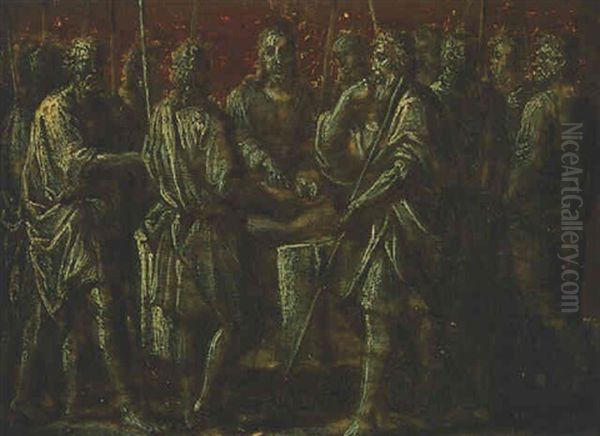
Polidoro was also an early adopter and master of chiaroscuro, the dramatic use of strong contrasts between light and dark. This technique, which would later be famously exploited by Michelangelo Merisi da Caravaggio (no direct relation, but from the same town), allowed Polidoro to create a sense of volume, depth, and heightened drama in his compositions. His red chalk drawings, many of which survive, further attest to his skill in rendering form and capturing expressive gestures with an economy of means. These drawings often possess a raw energy and immediacy that is highly compelling.
Key Roman Works
During his Roman period, Polidoro, often in collaboration with Maturino, produced a significant body of work, much of which, particularly the external frescoes, has unfortunately succumbed to time and weather. However, contemporary accounts, preparatory drawings, and later engravings by artists like Cherubino Alberti and Hendrick Goltzius help us appreciate the scope and impact of their creations.
One of the most important surviving interior projects by Polidoro is the fresco decoration in the chapel of Fra Mariano Fetti within the church of San Silvestro al Quirinale in Rome, executed around 1525-1527. These frescoes depict scenes from the lives of Saint Mary Magdalene and Saint Catherine of Siena. Here, Polidoro demonstrated his ability to work in color, though his characteristic dynamism and expressive figures are still prominent. The landscape elements in these frescoes are particularly noteworthy, showing a sensitivity to atmosphere and a departure from the more idealized landscapes of his High Renaissance predecessors.
His façade decorations, though largely lost, were legendary. Palaces like the Palazzo Gaddi and Palazzo Milesi were adorned with extensive friezes depicting Roman triumphs, mythological battles, and scenes of ancient virtue. These works were highly influential, studied by subsequent generations of artists visiting Rome. They contributed significantly to the visual culture of the city, making classical narratives accessible to a wider public. The surviving fragments and numerous drawings associated with these projects reveal Polidoro's fertile imagination and his ability to create complex, multi-figure compositions that animated the urban fabric. His work on the Vatican Logge, as part of Raphael's team, also remains a testament to his early contributions to major papal commissions.
The Sack of Rome and Flight South
The vibrant artistic milieu of Rome was brutally interrupted in May 1527 by the Sack of Rome. The mutinous troops of Holy Roman Emperor Charles V stormed the city, leading to a period of widespread pillage, destruction, and chaos. This catastrophic event had a devastating impact on the city's population and its artistic community. Patrons fled or were impoverished, workshops were disbanded, and many artists were forced to seek refuge elsewhere.
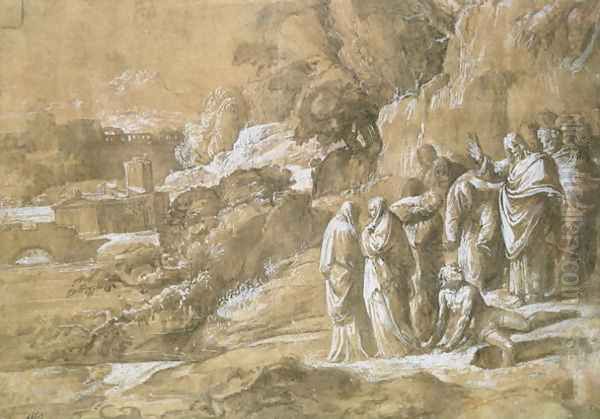
For Polidoro da Caravaggio, the Sack of Rome marked a dramatic turning point in his life and career. The city that had nurtured his talent and provided him with fame was now a place of turmoil and uncertainty. His close collaborator, Maturino da Firenze, is believed to have died either during the Sack or shortly thereafter from the plague that followed, a profound personal and professional loss for Polidoro.
Forced to flee the devastated city, Polidoro initially made his way south to Naples. This move, born out of necessity, opened a new chapter in his artistic journey, exposing him to different artistic influences and patronage systems. The experience of the Sack and the loss of his friend likely contributed to a more somber and emotionally charged quality that becomes increasingly evident in his subsequent works.
Years in Naples
Upon arriving in Naples around 1527-1528, Polidoro found a city with its own distinct artistic traditions, influenced by Spanish and earlier Netherlandish art, as well as by the Italian Renaissance. He quickly established himself as a leading painter. In Naples, he received commissions for altarpieces and other religious paintings, a shift from his predominantly façade-focused work in Rome.
One of his most significant Neapolitan works is the Way to Calvary (also known as Christ Carrying the Cross), painted around 1530-1534, now housed in the Museo di Capodimonte in Naples. This large and powerful altarpiece showcases Polidoro's mature style, characterized by dramatic lighting, expressive figures, and a palpable sense of pathos. The composition is crowded and dynamic, conveying the chaos and emotional intensity of the scene. His use of chiaroscuro is particularly effective here, heightening the drama and focusing attention on Christ's suffering.
During his time in Naples, Polidoro's work began to exhibit a more pronounced Mannerist tendency, with elongated figures, complex poses, and a heightened emotionalism. He interacted with local artists, including Andrea Sabbatini (also known as Andrea da Salerno), a prominent Neapolitan painter who had himself been influenced by Raphael. Polidoro's presence in Naples undoubtedly contributed to the development of painting in Southern Italy, introducing new stylistic currents from Rome. However, his restless spirit and perhaps the lingering trauma of the Sack of Rome led him to move again, this time further south to Sicily.
Life and Work in Messina
Around 1528 or shortly thereafter, Polidoro da Caravaggio relocated to Messina in Sicily. He would spend the remainder of his life there, continuing to produce significant religious paintings. His Sicilian works often display an even greater emotional intensity and a darker palette than his Neapolitan pieces, perhaps reflecting a more introspective turn.
In Messina, he painted several important altarpieces. Among his notable works from this period is the Adoration of the Shepherds, now in the Museo Regionale di Messina. This painting is characterized by its rustic realism, its dramatic use of light emanating from the Christ Child, and the deeply felt piety of the figures. The composition is less idealized than his earlier Roman works, showing a greater interest in capturing the raw emotion and humanity of the sacred event. Other works, such as a Deposition or Lamentation over the Dead Christ, further exemplify his capacity for conveying profound grief and spiritual depth.
His style in Messina continued to evolve, sometimes incorporating elements of local Sicilian artistic traditions while retaining the core characteristics of his Mannerist approach. He was a respected figure in Messina, receiving commissions from churches and confraternities. Despite his distance from the major artistic centers of Rome and Florence, he maintained a high level of artistic production and innovation. His influence on Sicilian art was considerable, introducing a more modern and expressive style to the island.
Tragic Death
The final chapter of Polidoro da Caravaggio's life, as recounted by Giorgio Vasari, is one of shocking tragedy. According to Vasari's Lives of the Artists, Polidoro had amassed a considerable sum of money in Messina and was planning to return to mainland Italy, possibly to Rome. However, his wealth attracted the greed of one of his assistants or servants.
In 1543, this servant, described as a "garzone" (young apprentice or shop-boy), allegedly murdered Polidoro in his bed by strangulation or by other violent means, with the intent of robbing him. To cover up the crime, the servant then reportedly carried Polidoro's body and placed it at the door of the house of a woman Polidoro was supposedly involved with, attempting to make it appear as if he had been killed in a crime of passion or by a rival.
The truth, however, eventually came to light, and the servant was apprehended and executed for his crime. Polidoro da Caravaggio was given an honorable burial in Messina, mourned by the citizens who had come to respect his artistic contributions. He was approximately 50 years old at the time of his death. This violent end cut short the career of an artist who, despite the disruptions and personal losses he endured, had consistently produced work of high quality and originality.
Legacy and Influence
Polidoro da Caravaggio's legacy is complex. While highly regarded in his lifetime, especially for his Roman façade decorations, his reputation somewhat faded in subsequent centuries, partly due to the loss of many of his most prominent works. However, his influence was significant, particularly on the development of landscape painting and on artists who valued expressive draughtsmanship and dramatic composition.
His Roman façades, though ephemeral, set a standard for this type of decoration and were studied by many artists. Later painters, including Annibale Carracci and Peter Paul Rubens, are known to have admired and sketched Polidoro's work during their time in Rome. Rubens, in particular, was a great admirer of Polidoro's dynamic compositions and his ability to evoke classical antiquity. Nicolas Poussin, another key figure of the Baroque era who spent much of his career in Rome, also drew inspiration from the classical narratives and frieze-like compositions favored by Polidoro.
The survival of many of Polidoro's drawings has been crucial for understanding his artistic process and his skill as a draughtsman. These drawings, often executed in red or black chalk, reveal his ability to capture movement, emotion, and anatomical understanding with remarkable facility. Engravings made after his designs by artists such as Cherubino Alberti and Hendrick Goltzius also helped to disseminate his compositions to a wider audience and preserve the memory of his lost frescoes.
Within the broader context of Mannerism, Polidoro can be seen as a distinctive voice. While he shared some characteristics with other Mannerist painters like Rosso Fiorentino, Pontormo, or Parmigianino – such as elongated figures, complex spatial arrangements, and heightened emotionalism – his particular strength lay in his narrative power and his innovative use of monochrome. His later religious works in Naples and Messina, with their somber intensity, anticipate some aspects of the Counter-Reformation art that would follow.
Conclusion
Polidoro Caldara, known as Polidoro da Caravaggio, was an artist of considerable talent and innovation whose career traversed the High Renaissance and the early stages of Mannerism. From his humble beginnings as a laborer in Raphael's workshop, he rose to become a celebrated master of façade decoration in Rome, working in close partnership with Maturino da Firenze. His mastery of grisaille, sgraffito, and chiaroscuro allowed him to create dynamic and classically inspired narratives that enlivened the urban landscape.
The Sack of Rome in 1527 forced a dramatic shift in his life, leading him to Naples and then Messina, where he continued to produce powerful religious paintings marked by increasing emotional depth and a distinctive, somewhat melancholic style. His tragic murder in 1543 cut short a career that, despite its peripatetic nature, consistently demonstrated artistic integrity and a restless creative spirit. Though many of his most famous works are lost, Polidoro da Caravaggio's influence on subsequent artists and his contribution to the diverse tapestry of 16th-century Italian art remain significant, securing his place as a unique and compelling figure in art history.